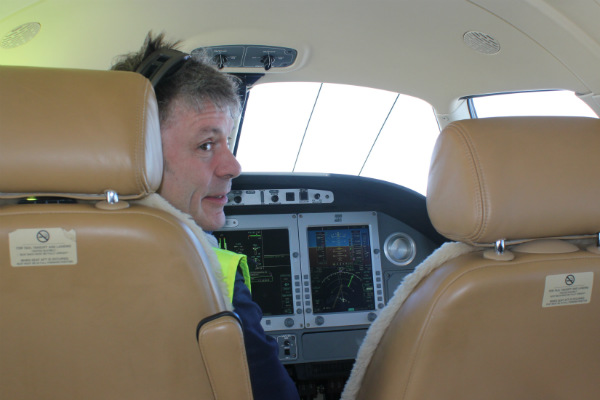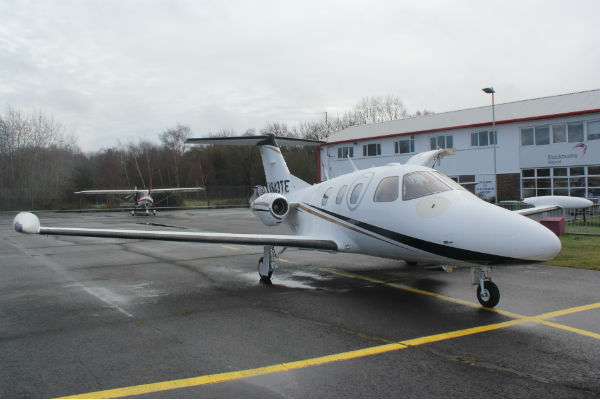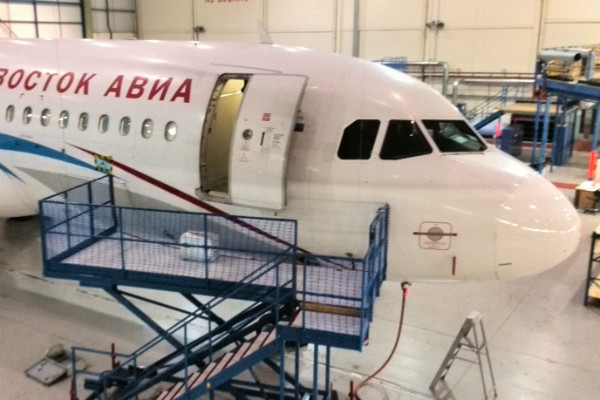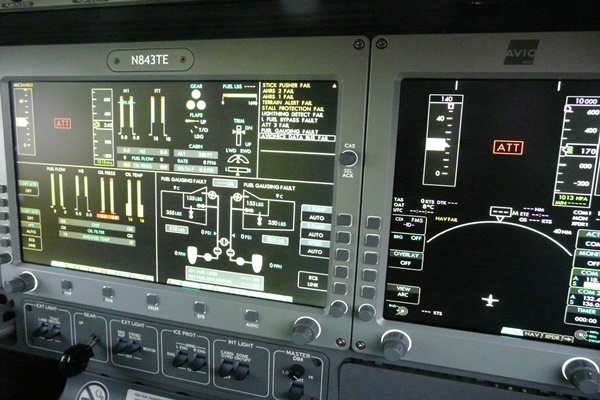Flying private with Iron Maiden’s Bruce Dickinson

Bruce Dickinson flies the Total Eclipse business jet.
Iron Maiden’s Bruce Dickinson flies Corporate Jet Investor from Blackbushe Airport, near London, to St Athan-Cardiff on the Total Eclipse business jet.
I should probably admit right from the start that I was a little bit skeptical about flying on the Total Eclipse.
While I have never been particularly convinced about the aircraft itself – or the very light jet model in general – the weather leading up to the day hadn’t been perfect for flying, so it was with trepidation that I arrived at Blackbushe Airport in the south of England to meet up with Cardiff Aviation’s Bruce Dickinson.
ALSO READ: Quizzing Iron Maiden’s Bruce Dickinson on the Eclipse 550
Dickinson, front man for heavy metal rock group Iron Maiden and former airline pilot, joined the board of European Eclipse distributor Aeris Aviation late in 2013 as non-executive chairman and had kindly offered to take Corporate Jet Investor for a flight in the Total Eclipse.
The Eclipse we’ll be flying on today is 2007-build msn 0072 / N843TE, originally delivered to Helijet Holdings in Texas, but now owned by Aeris Aviation and based at Dunkeswell Airport in the UK. Although it’s one of the older Eclipse 500 models, the aircraft has been upgraded to Total Eclipse standards and now includes added system functionality, the most important of which is GPS-coupled autopilots.
Meeting Bruce Dickinson
After brief introductions, Bruce gives us a quick look around the aircraft, both inside and out. The aircraft today is fitted with two seats in the back, one for me and the other for Corporate Jet Investor’s deputy editor Alex Andrews, who is also along for the ride.
https://vimeo.com/87688250
Before we can depart to St Athan-Cardiff Airport in South Wales, we’re taken to the Blackbushe cafe, where Dickinson tells us all about the Eclipse, his involvement with Aeris Aviation and some upcoming developments over tea and coffee.
Total Eclipse of the heart
It’s fairly clear from the start that Dickinson has a bit of a love affair with the Eclipse, telling us all about the aircraft with a wide smile and a glint in his eye.
He tells us about his flights the previous day, a zig-zag that started from Blackbushe and visited Cardiff, Southend and Cranfield, before getting him back to Blackbushe in time for dinner with his family in West London.
Bruce estimates the hourly cost of the Eclipse to be £500 (less than $850) and enthuses about how the previous day’s flying wouldn’t be possible in any other jet. He talks about the Eclipse using smaller airports, EASA’s problems certificating the Eclipse 550 due to the US shutdown and talks with passion about upcoming plans with Aeris Aviation.
One of the most interesting developments is a proposal for an Eclipse 550 ownership scheme that would work in a similar way to fractional jet ownership. Under the scheme, a maximum of four owners would enter into a company that purchases an Eclipse 550. That company would then be added to Cardiff Aviation’s Air Operator’s Certificate (AOC), with the company managing and flying the aircraft on behalf of the owners.
Later in the day we’re shown the Cardiff Aviation facility at the main Cardiff International Airport and it’s proposed that this is where the jets will be based. Cardiff International sees few business aircraft flights (although we notice a pair of King Air 200s sat on the ramp), but the airport operates 24 hours a day, so Dickinson sees Cardiff as the perfect base for a fleet of Eclipses.
Dickinson commits flying
Walking back to the Eclipse I tell Dickinson that after seeing a picture of the jet, my wife tried to stop me from coming today. I’m expecting a missive about how comfortable and safe the Eclipse is, but instead he just smiles and tells me that I should have just brought her along for the ride so she can see for herself.
That comment in itself tells us a lot about the confidence Dickinson has in the aircraft he’s flying and soon enough we’re strapped in and given our full safety briefing by Captain Dickinson.
https://vimeo.com/87688255
Fortunately, the wind that had been battering the UK for much of the last few months is taking a break and the rain has calmed down too. After a brief exchange with Blackbushe tower, we’re given permission to taxi off the ramp and hold short of runway 25.
Turning to us with a broad smile, Dickinson says “let’s commit flying” and gently spools up the engines as we enter the runway. The Eclipse’s power to weight ratio of 1:3.3 at MTOW makes getting off the ground an easy task and in no time at all we’re gently lifting into the sky above the Hampshire countryside.
Cruising to Cardiff
As we’re only flying a short distance today, our cruising altitude is 13,000 ft, although the aircraft is certificated to fly at 41,000 ft. Dickinson explains that the aircraft handles like a bigger jet, which makes it a pleasure for him to fly.
Inside the cabin Alex and I are busy snapping away on our cameras; the level of noise in the cabin isn’t as high as I was expecting and we don’t have issues hearing each other talk.
Barely 15 minutes in our flight, we start approaching St Athan. On the radio, we can hear the St Athan tower refusing to let us descend lower until we’re visual with the airport. Later, Dickinson tells us that the cloud-base was low enough that he thought we might have to do a go-around.
Eventually we break through cloud at around 2,500 ft and get a bird’s-eye view of the main airport on the left-hand side. Soon we’re lined up on runway 08 at St Athan and our rock star pilot gently glides the jet down for the smoothest landing I’ve ever experienced.
After a long role out, we’re quickly parked up at St Athan – which incidentally featured in finale of Sherlock Season 3 – where the only other aircraft in sight are ones that are being dismantled.
A tour of Cardiff Aviation
St Athan is home to Cardiff Aviation, which Dickinson co-owns with Mario Fulgoni, and he takes a great deal of pride on showing us around the facilities.
As well as scrapping aircraft, Cardiff Aviation also offers a full-range of maintenance options, and in two of the company’s largest hangars today are a Mongolian Boeing 737-800 and a Vladivostock Avia Airbus A320.
The hangars the aircraft are housed in were once used by the Royal Air Force for maintaining the old Vickers VC-10 tanker aircraft and much of the equipment still remains.
One of Cardiff Aviation’s plans for the future involves completion work on Boeing BBJs, with the company currently bidding for its first contract. Dickinson walks us through the hangar that would be used.
We then visit Cardiff Aviation’s facility at Cardiff International. We step inside a huge hangar, which contains three simulators side-by-side, two of which are Boeing 747 models, but the third is a Sikorsky S-61N helicopter simulator. Work is still being done inside, but Dickinson points out a red line across the hangar floor and tells us that a dividing wall will eventually separate the simulators from the business jet hangar.
After our tour of Cardiff Aviation, it’s time to fly back or “commit flying” as Dickinson would say. But before we can leave, Dickinson is asked to sign a few posters for the Iron Maiden film ‘Flight 666.’ It turns out that a lot of airline CEOs were Iron Maiden fans when they were growing up.
Back to Blackbushe
Back on the Eclipse, it’s my turn to sit up front. After my un-glamorous clamber into the right-hand seat, Dickinson talks me through the systems. This morning, he had talked about how easy it was to program the Flight Management Computer with the built-in keyboard and he quickly enters in the details for the flight.
The flight from St Athan to Blackbushe is one that been done quite a few times and Dickinson is quickly able to load up a stored flight plan, which has an estimated 24 minute flight time. After departure from St Athan’s runway 08, we’ll make a left hand turn and then point the jet directly at Blackbushe.
We’re given clearence by St Athan tower to start up and soon we’re on our way to the runway, entering at the 26 end and backtracking for a 08 departure.
Dickinson is keen to tell us that the Eclipse doesn’t need the full length of the runway to depart and true to his word, we slow down half way down the runway and start to turn around.
Spooling up the engines half-way through the turn, we start to pick up speed. We’re not locked on the runway center-line by this point, but we’re skillfully overmanned until the front wheel lines up. A gentle nudge forward of the throttles and we’re powering down the runway and off above the Welsh countryside.
Once we reaching our cruising altitude of 13,000 ft, Dickinson talks me through the AVIO NG cockpit suite, showing me that everything he changes on his display is also changed on the screen in front of me. It’s a bright and clean system, with any changes being made to the on-screen display popping out for a few seconds so you can see what’s been changed.
Soon we’re alerted by Air Traffic Control to some traffic crossing in front of us at a few hundred feet below and we turn into a pair of plane spotters, both scanning the horizon to see if we can see the aircraft.
The aircraft soon passes us several miles in front from left to right and once a safe distance we’re given clearance to start our decent into Blackbushe.
Handed off by Farnborough to Blackbushe, we’re given permission to join the left-hand circuit for an approach to runway 25 and Dickinson turns off the auto-pilot, electing to fly the approach himself.
The approach is smooth and controlled and we’re soon back on firm ground having completed a pair of flights that have completely changed my opinion of the Eclipse.
A great little aircraft
So what did I really think? Although I had an open mind about the aircraft, there was a lingering thought at the back of my mind that this little aircraft would be exactly that: a small aircraft that might as well be a twin turboprop.
But I must confess that I was actually really impressed with the Eclipse. With a power to weight ratio of 3:1, the aircraft took off effortlessly and the smoothness of the ride was far better than anticipated.
It’s clear to see why Dickinson is so enamored with the Eclipse. It’s a great little aircraft capable of flying four people comfortably for up to two hours. Dickinson told us that he wished they made a slightly longer version that could accommodate a rear lavatory, but over short distances this isn’t much of an issue.
Together with Aeris Aviation, Dickinson has big plans for the Eclipse 550 in Europe and it’s not hard to see why. Essentially, the aircraft returns to the basic premise of business aviation. It gets you from one point to another quickly and comfortably and in doing so, it becomes the essential business tool that a private jet should be.













